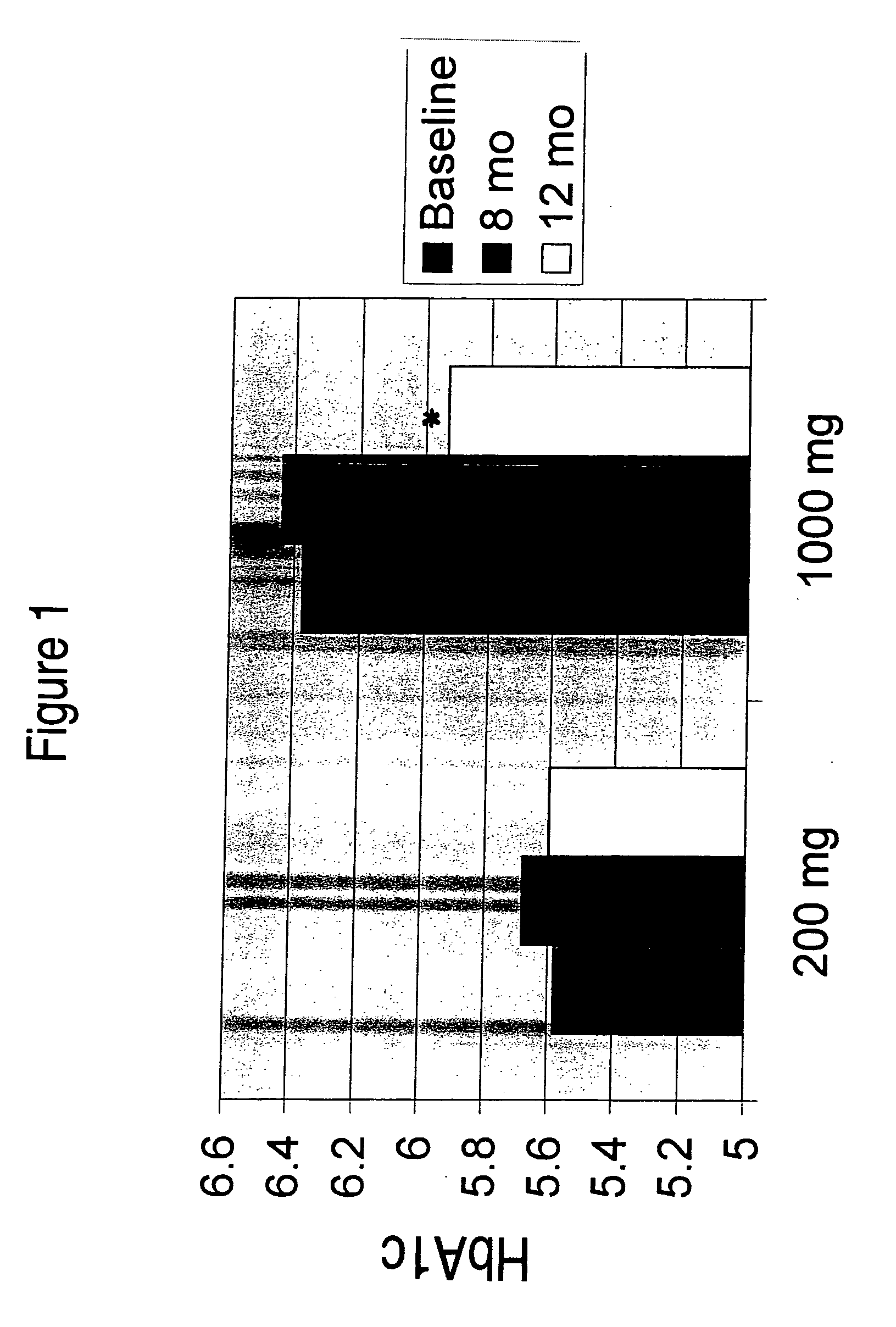Glycemic control for prediabetes and/or diabetes Type II using docosahexaenoic acid
a technology of docosahexaenoic acid and prediabetes, which is applied in the field of new diabetes patents, can solve the problems of/or diabetes type ii, affecting the clinical treatment of prediabetes, and limb loss, and reducing the cost and/or side effects of medications, so as to reduce the cost of medications and/or side effects, the effect of reducing the hbac1 or fasting
- Summary
- Abstract
- Description
- Claims
- Application Information
AI Technical Summary
Benefits of technology
Problems solved by technology
Method used
Image
Examples
example 1
[0071] In a clinical study, DHASCO capsules (which contained DHA as a triglyceride oil extracted from Crypthecodinium cohnii cells, obtained from Martek Biosciences Corp., Columbia, Md.) were co-administered with statin medication to patients with dyslipidemia. Hyperlipidemic patients already being treated with a stable dose of a statin medication but still failing to meet NCEP guidelines for LDL-cholesterol or triglycerides were treated with either 200 or 1000 mg of DHA daily for 12 months. HbA1c levels (glycosylated hemoglobin, a marker of glycemic control) were measured in plasma at baseline and after 8 or 12 months of treatment. The HBA1c levels were significantly reduced in the high dose group (1000 mg DHA / day) after one year of treatment compared to the low dose group (200 mg DHA per day). These results are shown in FIG. 1.
[0072] In this study, thirteen of 20 patients treated with DHA showed reductions in CRP levels, for an overall reduction of 15%. Reduction in CRP of this ex...
example 2
[0073] DHASCO-S capsules (which contained DHA as a triglyceride oil extracted from Schizochytrium sp. cells, obtained from Martek Biosciences Corp., Columbia, Md.) were used in the following study. Subjects (n=57) were enrolled in a randomized, double-blind, controlled trial to assess the response to 1.52 g of DHA per day for six weeks. Subjects were aged 21-80 and had HDL levels below the sex-specific median (a criterion for metabolic syndrome). The average triglyceride (TG) level at the beginning of the study was 169-179 mg / dl (metabolic syndrome criterion >150 mg / dL). The average distribution of LDL particles in this population was 44-50% small dense particles. Small dense particles are another lipid hallmark of metabolic syndrome. Taken together the subjects in this study exhibited up to 3 of the lipid markers of metabolic syndrome. The average waist circumference for men and women combined was about 100+ / -2.5 cm (criterion for metabolic syndrome is about 88 cm for women and abo...
example 3
[0079] The following clinical study may be carried out to validate the results of the clinical trial described in Example 1. For the purpose of the study a prediabetic will be an individual with a fasting glucose level between 100 mg / dL-126 mg / dL. The study population of pre-diabetics will be randomly divided into three treatment groups comprising at least 100 individuals each. The first treatment group will receive DHA (as capsules containing DHA as a triglyceride oil extracted from Crypthecodinium cohnii cells, obtained from Martek Biosciences Corp., Columbia, Md.) according to the invention in the amount of 1 g DHA / day. The second treatment group will receive EPA in the amount of 1 g EPA / day. The third treatment group will receive a placebo which will contain olive oil or a suitable substitute in the same amount of triglyceride. Each group will maintain the treatment course for a period of at least six months, more preferably one year. Over the evaluation period testing for fasti...
PUM
| Property | Measurement | Unit |
|---|---|---|
| body weight | aaaaa | aaaaa |
| weight ratio | aaaaa | aaaaa |
| time | aaaaa | aaaaa |
Abstract
Description
Claims
Application Information
 Login to View More
Login to View More - R&D
- Intellectual Property
- Life Sciences
- Materials
- Tech Scout
- Unparalleled Data Quality
- Higher Quality Content
- 60% Fewer Hallucinations
Browse by: Latest US Patents, China's latest patents, Technical Efficacy Thesaurus, Application Domain, Technology Topic, Popular Technical Reports.
© 2025 PatSnap. All rights reserved.Legal|Privacy policy|Modern Slavery Act Transparency Statement|Sitemap|About US| Contact US: help@patsnap.com

